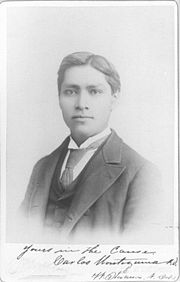
Carlos Montezuma
Encyclopedia

Yavapai people
Yavapai are an indigenous people in Arizona. Historically, the Yavapai were divided into four geographical bands that considered themselves separate peoples: the Tolkapaya, or Western Yavapai, the Yavapé, or Northwestern Yavapai, the Kwevkapaya, or Southeastern Yavapai, and Wipukpa, or Northeastern...
/Apache
Apache
Apache is the collective term for several culturally related groups of Native Americans in the United States originally from the Southwest United States. These indigenous peoples of North America speak a Southern Athabaskan language, which is related linguistically to the languages of Athabaskan...
activist and a founding member of the Society of American Indians
Society of American Indians
The Society of American Indians was a progressive group formed in Columbus, Ohio in 1911 by 50 Native Americans, most of them middle-class professional men and women. It was established to address the problems facing Native Americans, such as ways to improve health, education, civil rights, and...
.
Biography
He was named "Wassaja" (which means "signaling" or "beckoning") by his parents. His father was a chief named Co-cu-ye-vah and his mother was named Thil-ge-ya. In 1871 he was captured by PimaPima
The Pima are a group of American Indians living in an area consisting of what is now central and southern Arizona. The long name, "Akimel O'odham", means "river people". They are closely related to the Tohono O'odham and the Hia C-ed O'odham...
raiders who sold him to photographer Carlo Gentile for thirty dollars. Carlo Gentile renamed Wassaja "Carlos Montezuma", partly after himself.
The two resided in both Chicago and New York for several years until Gentile lost all of his belongings in a fire and had to send Montezuma away. On returning to Illinois Carlos Gentile placed the young Montezuma/Wassaja with Reverend G. W. Ingalls of the Indian Department of the American Baptist Home Mission. Carlo Gentile committed suicide soon after this. Carlos thereonin continued his studies and was tutored for entrance into the state university. After acceptance, Montezuma excelled in chemistry at the University of Illinois and graduated in 1884. He received his doctorate of medicine from the Chicago Medical College, a branch of Northwestern University, in 1889 and obtained his license to practice that same year.
Dr. Montezuma’s first venture in private practice proved to be unsuccessful. He closed up shop and soon found work as a physician with the Bureau of Indian Affairs (BIA) where he traveled to reservations and provided services to Native Americans in North Dakota, Western Shoshone Agency in Nevada, Colville Agency in Washington, and finally the Carlisle Indian Industrial School in Pennsylvania. Here, he became acquainted with Richard Henry Pratt, founder of the Carlisle Indian School and staunch assimilation-ist. This relationship, along with his negative experiences working on various reservations, helped form his early ideas of Indian policy.
By 1896 Dr. Montezuma left Pratt to return to Chicago and start another private practice. He successfully practiced medicine and began publicly attacking the government for the conditions imposed upon Natives.
Montezuma became an outspoken opponent of the Bureau of Indian Affairs (BIA); he was twice offered the post of commissioner of Indian affairs but refused. Instead, he helped found the Society of American Indians in 1911, the first Indian rights organization created by and for Indians. In 1916 he started a monthly magazine titled Wassaja that he used as a platform to spread his views of the BIA and Native American education, water rights and citizenship.
At the turn of the century, Dr. Montezuma traveled as team doctor with Coach Pop Warner's National Champion Carlisle Indian School football team to Arizona. While in Arizona, Montezuma contacted long-lost relatives he had not seen since his abduction. By this time, the Yavapai were settled at Fort McDowell reservation. Montezuma’s hatred for the reservations softened once he saw how connected his people were to their ancestral land and understood that they considered it home. Thereafter, he led the Yavapai resistance of removal from Fort McDowell until his death.
Dr. Montezuma became very ill in 1922 and decided to permanently return to the land of his people. He died on January 31, 1923 of tuberculosis and is buried at the Fort McDowell Indian cemetery. The memory of his work faded until the 1970s when historians rediscovered his work.
In 1982 Peter Iverson wrote a biography of Montezuma/Wassaja.
External Links
- Carlos Montezuma Papers at Newberry LibraryNewberry LibraryThe Newberry Library is a privately endowed, independent research library for the humanities and social sciences in Chicago, Illinois. Although it is private, non-circulating library, the Newberry Library is free and open to the public...

